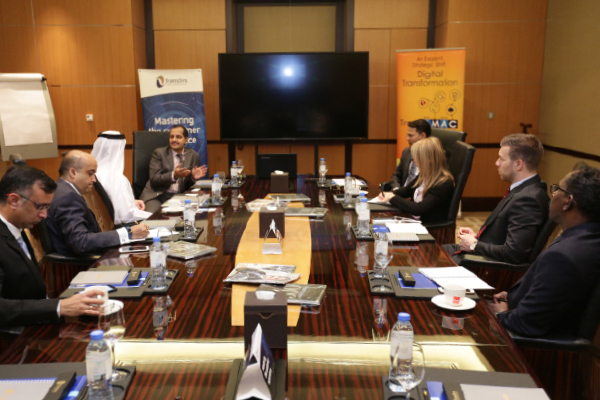In partnership with TransSys Solutions, CNME hosted a roundtable discussion centred around how organisations can maximise business value by incorporating customer experience into their digital initiatives.
In this competitive digital age, new technologies are diminishing traditional marketing methods as customer expectations and behaviours continue to evolve. Businesses now need to ensure that they have a complete holistic view of their customer’s experience (CX) if they are to keep up with changing demands and stand a chance of competing in the digital space. “It’s now about tracking a customer’s digital body language,” said Stephen Fernandes, executive vice president, TransSys Solutions, who was representing the sponsor during the discussion alongside Prabu Balasubramanian, the company’s executive director.
The discussion began by analysing how best to capture customer experience through the use of beacon technology. Most commonly found in the retail industry, beacons can detect where a customer is at any given moment. From this, the retailer can push timely messages to promote products and increase sales volumes.
Ahmed Ebrahim AlAhmed, CIO, Nakheel discussed how precise location services could mutually benefit the merchant as well as the customer in a retail scenario. “Whenever a customer logs onto the public Wi-Fi within a mall, they’re automatically giving the merchant the permission to access their social media applications,” he said. “This data can be used to analyse the customer preferences, and the merchants can then use this information to promote discounts and push them to buy products.”
The question was then raised as to whether or not customers are made fully aware of the terms and conditions they are accepting when logging into these public Wi-Fi hotspots, with regards to how much of their information can be used for other purposes, including beacon technology.
“Privacy is not there anymore in IT,” said Anshul Srivastav, CIO, Union Insurance. “The real question is whether a customer is prepared to reveal their shirt size to benefit from 10 percent off his next purchase, and the chances are that they will. Technology pushes you to expose yourself to get the benefits.”
Madhusuthan, IT manager, Bahri and Mazrouei, agreed with Srivastav, and maintained that privacy is a matter of choice. “It all rests on the individual’s decision,” he said. “If they see themselves benefiting from accepting these pop-ups and terms that come hand-in-hand with accessing a public Wi-Fi, then they are likely to be willing to give access to their information.”
Nitin Bhargava, CTO, Business Technology, Mashreq Bank, does not see a privacy issue when the marketing is targeted at the customer on a one-to-one basis. He did, however, see a problem when data is being shared with external marketing outlets that the customer did not sign up to. “Take Amazon for example; they’re fantastic at social marketing,” he said. “The second you search for a product through their site, they’re constantly exposing you to promotions or deals via your social media. This isn’t a problem, as its individually targeted.”
The general consensus in the room was that collating data in order to improve customer experience is the easy part, and that the challenge arises when it comes to interpreting this data to establish the satisfaction of customers.
“We have started looking at the unstructured material data – which is coming through social media and various other data points – in order to put that into much more measurable and meaningful outputs,” Srivastav said. “This should enable us to actually access a 360-degree view of a customer’s experience.”
“The main indication of customer satisfaction is through volumes of repeat behaviour,” said Bhargava. “If a customer is looking at composing 1000 plus transactions with Mashreq Bank, but suddenly that drops to 500 transactions, then there’s a problem. I would then want to analyse this pattern by tracking customer behaviour and satisfaction to work out where we had gone wrong for them to take their business to another bank.”
The conversation then moved on to taking stock of where companies in the room were at with their current initiatives surrounding customer experience.
Ali Ghunaim, director of IT, Canadian Specialist Hospital, highlighted the importance of enhancing patient experience while also ensuring that doctor’s do not waste time on monotonous tasks. “One initiative to enhance experience for both doctors and patients alike, is one that allows doctors to connect to the hospital’s VPN via their device and use the hospital’s app in order to have access to patient information as and when it arrives,” he said. “Because of this, rather than requiring the doctor to physically make the trip to see the patient, they can – where necessary – simply advise on what needs to happen remotely from wherever they are in the hospital, which saves making unnecessary journeys and wasting time.”
Ensuring morale was kept high among internal staff was also a high priority for those present at the discussion.
“Employee satisfaction is a big thing for us and our CEO,” said Bhargava. “We are now looking at creating a social enterprise for employees, and want to encourage teamwork and good behaviour on a day-to-day basis to maximise business benefits.”
Kumar Prasoon, CIO, Safeer Group, said, “There is huge value in employee experience. If every employee becomes a part of the business game, it’s more of an incentive for them to meet targets and corporate objectives.” However, Prasoon maintained that the focus should primarily be on finding a balance between customer centricity and employee satisfaction if a business is to succeed.






